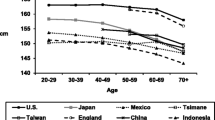Abstract
There are numerous reasons why mortality and life expectancy vary between countries. Epidemiological studies seem to indicate that dictary variations may be among them. A sample of 51 countries studied with data from the International Comparisons Project and other sources, shows that after controlling for nutrient intake, consumption of medical goods and services, income distribution, weather, and literacy, countries with more meat and poultry in their diet have lower life expectancies after age five. The results for infant mortality and child death between one and five indicate that a more animal-intensive diet may be actually be beneficial, especially if fish consumption is increased and meat and poultry consumption reduced.
Similar content being viewed by others
References
Behrman JR, Deolalikar AD (1988) Health and nutrition. In: Chenery H, Srinivasan TN (eds) Handbook of development economics. North Holland, Amsterdam, pp 631–711
Burr ML, Sweetnam PM (1982) Vegetarianism, dietary fibre and mortality. Am J Clin Nutr 36:873–877
Caldwell JC (1986) Routes to low mortality in poor countries. Popul Dev Rev 12:171–220
Colditz GA, Branch LG, Lipnick RJ, et al. (1985) Increased green and yellow vegetable intake and lowered cancer deaths in an elderly population. Am J Clin Nutr 41:32–36
DeBakey ME, Gotto AM, Scott LW, Forelit JP (1986) Diet, nutrition and heart disease. J Am Diet Assoc 86:729–731
Dwyer JT, Andrew EA, Bekey C, Valadian I, Reed RB (1983) Growth in “new” vegetarian pre-school children using the Jenss-Bayley curve fitting technique. Am J Clin Nutr 37:815–827
FAO (1971) FAO Production yearbook, vol 35. FAO Statistics Series No. 40, Rome
Flegg AT (1982) Inequality of income, illiteracy and medical care as determinants of infant mortality in underdeveloped countries. Popul Stud 36:441–458
Gwatkin DR (1980) Indicators of change in developing country mortality trends: The end of an era? Popul Dev Rev 6
Hobcraft JN, McDonald JW, Rutstein SO (1984) Socio-economic factors in infant and child mortality: A cross-national comparison. Popul Stud 38:193–223
Jain S (1975) Size distribution of income: A compilation of data. World Bank, Washington, DC
Kahn HA, Phillips RL, Snowdon DA, Choi W (1984) Association between reported diet and all cause mortality: Twenty-one year follow up on 27530 adult Seventh-Day Adventists. Am J Epidemol 119:775–787
Keys A, Aravanis C, Van Buchem FSP, et al. (1981) The diet and all causes death rate in the seven countries study. Lancet 2:58–61
Kolonel LN, et al. (1983) Role of diet in cancer incidence in Hawaii. Cancer Res (Suppl) 43:2397s–2402s
Kravis I, Heston A, Summers R (1982) World product and income. International comparison of real gross product. Johns Hopkins University Press, Baltimore
Lecaillon J, Paukert F, Morrison C, Germidis D (1984) Income distribution and economic development. International Labor Office, Geneva
Pampel FC, Pillai VK (1986) Patterns and determinants of infant mortality in developed nations, 1950–1980. Demography 23:525–541
Pan American Airways (1970) New horizons world guide
Pediatric Nutrition Handbook (1985) American Academy of Pediatrics
Preston SH (1976) Mortality patterns in national populations. Academic Press, New York
Preston SH (1980) Causes and consequences of mortality declines in less developed countries during the twenthieth century. In: Easterlin R (ed) Population and economic change in developing countries. NBER, New York, pp 289–360
Primrose T, Higgins A (1971) A study in human antepartum nutrition. J Reproduct Med 7
Saxon G (1983) Results of case control studies of diet and cancer in Buffalo, New York. Cancer Res (Suppl) 43:2409s–2413s
Snowdon DA, Phillips RL (1985) Does a vegetarian diet reduce the occurrence of diabetes. Am J Public Health 507–512
Verlangieri AJ, Kapeghan JL, Dean S, Bush M (1986) Fruit and vegetable consumption and cardiovascular mortality. Med Hypothesis 16:7–15
World Development Report (1981, 1982, 1983, 1987). World Bank, Washington, DC
Author information
Authors and Affiliations
Additional information
I thank Jere Behrman, David Crawford, Anil Deolalikar, the Managing Editor, two anonymous referees, and especially Samuel Preston for valuable comments, and Alan Heston and Robert Summers for being generous with their time and their data. Financial support was provided by a Compton Foundation Fellowship. All errors remain my responsibility.
Rights and permissions
About this article
Cite this article
Rao, V. Diet, mortality and life expectancy A cross national analysis. J Popul Econ 1, 225–233 (1989). https://doi.org/10.1007/BF00161480
Received:
Accepted:
Issue Date:
DOI: https://doi.org/10.1007/BF00161480




